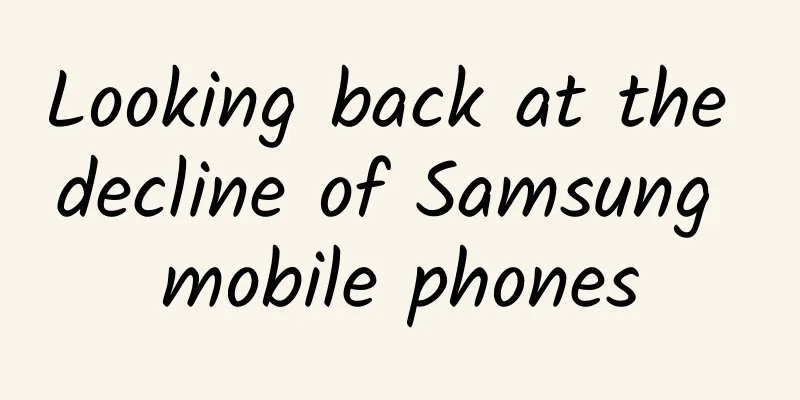Looking back at the decline of Samsung mobile phones

|
Faced with the success of its products, the Korean company is clearly a bit lost. It should have consolidated its victory, but it suffered from internal organizational chaos and external marketing was like being struck by lightning. Samsung wanted to learn from Steve Jobs and use the form of Broadway musicals to show some new features of Samsung phones. The outside world commented: "It's terrible. I really don't know where they learned this from." Now, even LeBron James, the spokesperson they chose for the phone, is complaining about the problem of Samsung's phone reboot on Twitter. Why did Samsung suddenly take a sharp turn for the worse? Now people think that one of the reasons for Samsung's success is that they danced where Nokia and others failed to do, making good use of what they already had, but failed to sustain it because their products were really mediocre and fell into the vortex of being attacked by Apple and Xiaomi at the high and low ends respectively. But after its huge success in 2011, few analyses of Samsung mentioned this. Obviously, when a company "doesn't know why it is successful, or believes in the wrong reasons for success, it is very dangerous - Samsung's example also applies to Xiaomi now and any company in the future. Back in November 2011, Samsung released a series of ads that positioned the company three years into the future: a group of hippie-dressed people waited in front of an Apple store to buy the next iPhone. As the time approached and they were about to buy Apple's "i" product, they noticed that other people on the street were using better phones. That phone, Samsung's former flagship Galaxy S II, had two key features that its rival, the new iPhone 4S, didn't: a big screen and 4G wireless access. And unlike the iPhone, you didn't have to wait in line for hours to buy the Galaxy S II; you could buy it right away. But neither Samsung nor any other product had the long lines of buyers that the iPhone had at the time. Just as Apple had poked fun at Microsoft with "I'm a Mac" in the 2000s, Samsung was using the same strategy - the little guy dancing in front of the big guys - and it worked for a while. Samsung's profit margins were as high as 76% at the end of 2012, thanks to the growth of its mobile business, which suddenly became Samsung's most profitable division. Samsung is also the only company other than Apple to maintain profits in the mobile field, and is quietly approaching Apple's dominance. This led to the famous headline "Can Apple Still Keep Calm About Samsung?" published by the Wall Street Journal in January 2013. When the Galaxy S4 was released in March 2013, the industry generally believed that only Apple's products could match it, officially declaring that the smartphone market had become a showdown between two manufacturers. But it only took a year for reality to collapse. In 2014, Samsung's profit margins were already shaky, even in the holiday season, which was traditionally its most profitable. Samsung blamed the decline on the increasing competition in the mobile field. As Samsung prepares for its most important smartphone launch ever on March 1, the question is whether the Galaxy S6 will be enough to turn around Samsung's fortunes or send it to the same fate as former kings Nokia, BlackBerry and Motorola. How did Samsung grow so quickly and then plummet? Competition from new rivals like Xiaomi and the all-new Apple was certainly the main reason, but organizational chaos, including a split between the Korean headquarters and the suddenly emerging U.S. division, also played an important role. The birth of the Galaxy series In 2008 and 2009, as the post-iPhone era of smartphones began, Samsung, like other manufacturers, desperately chased after Apple and still relied on wireless carriers to sell their phones, but their products were lost among the many other brands of devices on the shelves. Consumers were left with limited choices: iPhone, BlackBerry, or whatever device the carrier gave them with a two-year contract. According to reliable sources familiar with Samsung's plans, in 2009 Samsung decided to create a new brand for its flagship Android phone line. At the time, Samsung already had a revolutionary screen technology - Super AMOLED, and was ready to equip it with devices made by wireless operators such as Verizon. Samsung has been supplying chips and displays to other manufacturers, and it also hopes to charge patent licensing fees for Super AMOLED technology in the same way. Finally, Samsung decided to make its own high-end smartphones to compete with the iPhone, but the marketing was lackluster. The "Samsung" brand was synonymous with cheap flip phones and beautiful TVs, and was never compared to Apple, Blackberry, or Nokia. This alone could have declared a new product a failure before it even hit the market. Moreover, in a consumer survey of Apple, Samsung learned that its brand was rarely recognized as a representative smartphone manufacturer. Samsung really needed to change. So Samsung created a high-end sub-brand for its Android smartphones, like Lexus to Toyota. It called it Galaxy. In March 2010, Samsung released the first series of Android phones and tablets that would make it successful, the Galaxy S. The series had hardware configurations that were comparable to the iPhone, but its software and interface were also accused of copying Apple. But none of this seemed to matter, as there were still hundreds of carriers in the world that did not offer the iPhone, because AT&T had the exclusive right to sell the iPhone in the United States. Samsung signed deals with several wireless carriers to start promoting the Galaxy S in their stores in June. Even better, Samsung managed to get AT&T to start selling the Galaxy S, even though it's a strong competitor to the iPhone. The race between the two manufacturers Despite the success of the Galaxy S, Samsung still lagged behind rivals like HTC in the Android smartphone race. Both manufacturers made good phones, but neither had a compelling reason to buy. In the spring of 2011, Samsung was preparing to launch the Galaxy S's successor, the Galaxy S II. At the same time, Samsung also planned its marketing strategy for the product, at least in the U.S. market. Samsung’s Korean executives wanted Galaxy to become the No. 1 smartphone brand in the world within the next five years (Samsung ranked fifth in consumer surveys at the time), according to a person familiar with the company’s thinking at the time. Samsung’s chief marketing officer in the U.S., Todd Pendleton, and his team thought the goal was within a year and a half. Initially, Samsung's Korean leadership wanted to defeat competitors one by one, starting with HTC, then Motorola and BlackBerry, and finally Apple. But the American team decided to use a different approach and confront Apple head-on, thus starting the "Coca-Cola vs. Pepsi" war in the smartphone world. It's a gamble; going to war directly with Apple could leave Samsung looking pathetic and desperate. But the "Next Big Thing" campaign, created by the agency 72 And Sunny, was a blast. For the first time since the iPhone was released, it convinced people that there was a better option than the iPhone. Apple is more innovative As the "next big thing" ads were released all over the media, people realized that a manufacturer was beginning to dance with the industry king, and consumers began to respond. And all the criticism that Samsung copied Apple just proves that the market is in desperate need of something that the iPhone doesn't have - like a phone with a bigger screen. In the fall of 2011, Samsung announced that it had begun developing the Galaxy Note, the first tablet phone with a 5.3-inch screen. Compared with other mobile phones at the time, the Galaxy Note was definitely a standout. When it was released in February 2013, people criticized the Note for being too big. Walt Mossberg, a technology critic for the Wall Street Journal, quipped: "Holding the Note is like holding a piece of toast to your ear." The product was poorly received at first, with some US carriers reportedly refusing to sell the Galaxy Note II for the second year. But the phone sold well outside the US, especially in Asia, and Samsung finally proved that there was a market for tablet phones. Samsung's devices and screens were getting bigger, while iPhone users were left staring at their small phones in frustration. A powerful narrative began to circulate in the media: If Apple didn't launch a large-screen phone like Samsung, they would be in trouble. Many people asked if Apple had lost its knack for innovation after the death of Steve Jobs, and Samsung's momentum made this theory more plausible. Apple's stock price fell from $705 to $380, mostly due to market panic that Apple no longer had revolutionary products to show off. Meanwhile, Samsung's performance is still climbing. According to reports, Samsung's marketing of the Galaxy S series has also effectively boosted and increased the sales of Samsung's other products such as washing machines and refrigerators. The ad campaign was clearly a success, but not everyone at Samsung thought so. The time has passed The success of Samsung's mobile business in the United States has instead created a rift with its Korean headquarters. It is reported that the more successful Samsung is in the United States, the more complicated the relationship between it and the headquarters becomes. The American team feels that their outstanding work has been rewarded with harsh criticism rather than more trust. (Samsung declined to comment on this) Things were so bad that in the last three weeks of 2012, Samsung sent a planeload of executives to Dallas, the mobile business's U.S. headquarters, for an unannounced audit. Employees in Dallas had to sift through marketing materials for mobile products. They were accused of falsifying sales figures, bribing the media, and other serious behavior that damaged the company's image. The U.S. business unit that had elevated Samsung's brand to the same level as Apple was suddenly punished for their work. Three weeks later, the auditors from South Korea returned home without finding any problems with the U.S. office's operations, but the damage had been done, and from the Korean headquarters' perspective, the U.S. business unit had been successful but hadn't done anything good. In fact, in one meeting with the global team at Samsung’s headquarters in South Korea, executives had the U.S. team stand in front of hundreds of their colleagues in a large auditorium and have the others applaud them because they were the only team that had let the company down, even though everyone knew the opposite was true. This move directly killed the hope of replicating the success of the US team in other regions. They might be able to continue to do so in North America, but Samsung still lacked a global spread. In such a tense atmosphere, Samsung held a grand Galaxy S4 launch event at Radio City Music Hall in New York in 2013. Unlike traditional product launches, Samsung used a Broadway musical to introduce the features of the new phone. The spectacle was so bizarre that it had to be seen to be believed. Many criticized Samsung for creating a show that was a reference to women, with Molly Wood of CNET simply calling the show "tone-deaf" and "shockingly sexist." In addition to being criticized, the Galaxy S4 itself has also been plagued by negative news. Samsung piled it with features that were unnecessary or ineffective to promote, such as touchless controls, eye tracking, and a whole host of camera modes. Despite this, the phone has become the most successful product in the company's history, and 2013 is still a good year for Samsung. But in 2014, the alarm bells began to ring. A difficult year At the 2014 Mobile World Congress in Barcelona, Samsung said that in the past four years, the Galaxy S series has sold more than 100 million units. Only Apple can beat such flagship product sales figures. Samsung then released the Galaxy S5, which ditched many of the S4's flashy features and instead included useful new features like an upgraded camera and waterproofing. The S5, like its predecessors, had a plastic body, was unlocked, and cost $650. Based on the success of the Galaxy S4, Samsung was confident it wouldn't fail again. But they were wrong. Samsung's 2014 decline was caused by many factors, but the main culprit was Chinese manufacturers. Chinese startups like OnePlus and Xiaomi seemed to have mastered the secret of making beautiful, high-quality phones at half the price of an iPhone or Galaxy S series. Xiaomi was the most successful manufacturer of the year. It is, by some estimates, the top smartphone vendor in China, the second-largest smartphone market where hundreds of millions of people are switching to smartphones. Xiaomi phones are made of high-grade metal, so they look more premium than Samsung phones, and they have the familiar features: fast processors, high-resolution screens and high-quality cameras. Xiaomi's rise also means Samsung's decline in China. Because Xiaomi phones also use Android, there are few things that Samsung's high-priced models can do that Xiaomi can't. In addition, Xiaomi is also an example of successful marketing, with Mi fans queuing up in long lines just like Apple fans in Western countries, eager to buy products. Xiaomi relies on social media and word of mouth for most of its marketing, so it doesn't have to spend as much money on advertising as Samsung. But Xiaomi is only one factor. Ben Thompson, a technology analyst and blogger at Stratechery, points out that much of Samsung's success is due to its ability to distribute its products on a large scale before other companies can compete with the iPhone. For example, the iPhone is only available on about a third of the carriers that Samsung does, and in the United States, unless you're an AT&T customer, Samsung is one of your best options. The same is true for China Mobile, the world's largest wireless carrier with more than 700 million customers. Since Apple finally introduced the iPhone to China early last year, China has become one of the fastest-growing markets for the iPhone. Other users have turned to cheaper rivals from Xiaomi, Lenovo and others. "I think it's always very dangerous when you don't know why you're successful," Thompson said in an interview. "One of the reasons Samsung succeeded is that they did what Nokia and the like didn't do, they were good at using what they had but they couldn't sustain it because their products were really lackluster and they were caught in a vortex where they were squeezed by Apple and Xiaomi at the high end and the low end respectively." "At the end of the day, there's nothing different about Samsung phones anymore, so they can only compete on price," Thompson added. However, this doesn't seem to be Samsung's plan. New strategy On March 1, Samsung will release its latest two flagship phones, the Galaxy S6. One of them will have a metal body, saying goodbye to the previous plastic body; the other will have a curved screen, similar to the Galaxy Note Edge released last fall. But both models will still focus on the high-end and high-priced market. According to the latest leaked information, the non-contract version of the Galaxy S6 Edge may cost more than $1,000, which is at least equivalent to three Xiaomi phones. Unless Samsung has something particularly impressive to show for its software, these two new models don't seem to justify their high prices and the lack of performance of other similar Android devices. If so, it will be another year of trouble for Samsung, and the halo of the smartphone business has faded forever. It's time to do something new. This doesn't mean that Samsung is doomed. The company is still capable of making behemoths from dishwashers to air purifiers, and it still has the scale and manufacturing capabilities to build the next big thing, even if it doesn't come from its own R&D labs. Moreover, its chip business is already very profitable, growing rapidly on the back of its agreement with Apple to make processors for the next generation of iPhones. Samsung's near-term business will also focus on the "Internet of Things" (IoT), which connects everyday objects such as light switches and toasters to the Internet for further control. At the Consumer Electronics Show in January, Samsung announced that every one of its products will be able to connect to the Internet in the next few years. In theory, this will build a valuable ecosystem that connects everything in your home, creating a whole new group of Samsung customers. Samsung will still fondly recall the brief days when it went head-to-head with Apple. |
<<: Breaking the ice of the century: Understanding Apple and IBM's partnership
Recommend
【Smart Farmers】Looking at Field Crops from Space - Satellite Remote Sensing and Crop Mapping
In the news broadcast, we often hear such reports...
How to make users like your marketing ads?
Don’t try to bother users with things they don’t ...
International Museum Day丨Amazing! Take a look at these fashion items of the ancients
To create a sense of fashion, exquisite small ite...
Liquid oxygen-kerosene rocket engine: the "new engine" supporting China's space program
Author: Huang Xianghong Duan Yuechu In the journe...
The most comprehensive APP operation and promotion plan!
Now that you have the APP, the next step is to op...
As a newcomer to the industry, this is the most comprehensive industry learning strategy!
In the field of operations , a major difference b...
The dumb way to promote App online, the qualitative change from 0 to 1 million users
There are some stupid ways to promote apps online...
MBP battery life collapses: Why does Apple resort to such tricks to cover up its shame?
Every system update is exciting, after all, every...
The M1 chip successfully runs Linux, and the terminal starts the installation with one line of code, and can also delete and uninstall with one click
This article is reprinted with permission from AI...
Toutiao video information flow advertising marketing plan!
Toutiao video information flow advertising market...
Information flow creativity, but the conversion effect is always poor?
What is the most important characteristic of a co...
Emotional counseling/Second-tier e-commerce/Travel and travel... Landing page construction guide!
An epidemic has messed up everything, but the col...
A deep dive into the hidden rules of “WeChat Points Wall”!
In APP operation and promotion, especially iOS pr...
Yingke has been removed from the shelves again. Will this be a sign that it is in trouble?
The rumors of "selling out" have just s...
Things about bad code
[[148851]] 1. Summary This is the second article ...






![[2021 Summer] Senior 3 Physics Target A+ Model Physics Chapter Progress](/upload/images/67cc200003c9f.webp)


